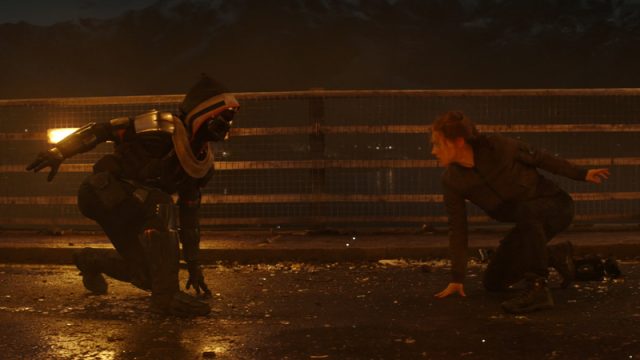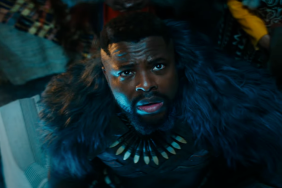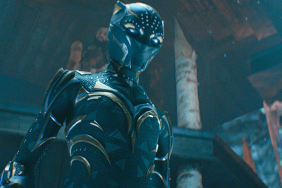Scanline VFX has had a busy year. Not only have they worked on projects such as Zach Snyder’s Justice League and Godzilla vs. Kong, but they were asked to handle a number of key sequences in Marvel’s summer blockbuster Black Widow.
Visual Effects Supervisor Mathew Giampa took the time to break down the work Scanline VFX did on Black Widow with ComingSoon, revealed his process when tackling such a massive project, and also explained the pros and cons afforded by new technology.
RELATED: Kit Harington Believes Eternals Is ‘the Tip of the Iceberg’ for Black Knight
Jeff Ames: First of all, can you discuss your role at Scanline VFX?
Mathew Giampa: I’m actually a visual effects supervisor at Scanline. I’ve been with them for eight years now. I started out as a compositor originally and then moved into lead compositor and comp supervisor and now I’ve been a visual effects supervisor for about three years now.
I’m the person that ends up talking to the client and gets information on what exactly they’re looking for. I’m the one who basically runs it through with my team of artists here at Scanline and we put plans together that clients ask us to provide for them.
I’m in charge of — well, it depends on the show. Sometimes we’re involved from the very beginning and we’re in the early stages of production and sometimes we get in after they’ve already filmed and have to develop concept art for sequences they might be working on, and run with whatever they want to go with.

For Black Widow, you guys were tasked to develop the Taskmaster vs. Black Widow fight scene on the bridge. Were there other sequences you were involved with?
Yeah, that was the main sequence we were working on and then we were also in charge of the safehouse sequence where we did an environment set extension. They shot that scene in this big field and they wanted to have some mountains in the background to make it look like it was Norway — it was filmed in the UK — so, we did that and we also did the Norway sequence, which was basically a sequence where Black Widow was coming out of the water carrying some vials. We had to do some grading on those and the environments in the background. We also worked on one of the flashback sequences — the bit where she’s in the car and an explosion occurs. We had to add the explosion to the window of the car.
But the bridge fight was our main sequence and it was the heaviest VFX we had to do for the show.
What is your approach to a sequence like this?
Basically, what happens is the client agrees they want to work with us. For the bridge fight I wound up in London to watch them film and they gave me a breakdown of what they wanted. They had an environment that they were looking for that was in the UK and wanted us to add a bridge located in Norway into that environment. They built a half replica of the bridge to shoot the practical stuff on and then we added set extensions and explosions. Since most of it was filmed on a set without water we had to build out an entire environment. We actually built out 10 kilometers of the environment in 3D. The environment was all fully CG out there and half the bridge was also CG.
Basically, they just told us what they were looking for and we just went about creating all of the elements and made them as realistic as possible.
The best thing about filming the sequence this way was that they were very specific about how everything should look, and they specifically wanted real-world locations; so, it wasn’t something where we were randomly coming up with or trying to decide how to build the environment from scratch. That part was pretty much set and we just had to build it from there. We had some concept art that they would provide to us and [the] exact dimensions of the bridge so we could build it to proper scale.
So, what you’re saying is this was a piece of cake, no challenge project, right?
[Laughs] I wish that was the case. Unfortunately, there’s always hiccups and problem solving you have to do. A lot of it comes down to the creative process. The Marvel films have a very specific style, and we were thinking that was the direction they wanted to go with the environment – colorful and stylized. Not too stylized, but more stylized than you would normally get, but they wanted something a little more grounded and a little more realistic. We ended up playing around with that a bit and had to figure out what they wanted, which was a challenge.
Also, a lot of times you film stuff on set and it doesn’t come out correctly, so there’s a lot of technical aspects of trying to recreate what they were trying to accomplish on set and we have to do it in full CG. The car flipping, for example — they filmed that on set, but it didn’t come out properly. So, we had to go in and reanimate the car and do the explosion so the car would land in the place they wanted; and also have a more interesting camera movement. What was nice is they actually flipped the car on set, so we could see how it reacted when it got blown up.
But, there’s definitely some technical aspects that were challenging. And also, the timeframe they wanted everything done was challenging – this was one of the shortest post productions Marvel has ever done. That also became a challenge because building out an entire environment — you know, 10 kilometers is a lot of work, especially when you have a lot of trees and mountains and you’re trying to get enough variety to make it realistic. It’s a tedious process and there’s a lot of back and forth to make it work.
Do you ever want to yell at an audience, “Do you see that? That’s a visual effect shot! We did that and you don’t even realize it!”
[Laughs] Surprisingly, no. We actually really appreciate when people don’t realize what we did – that means we did our job, right? I prefer to keep it lowkey. If people don’t know and if people aren’t questioning it, then that makes me happier than if people are questioning the FX they see on screen.
But there are times where people will ask what we did in a film and are surprised when we tell them what we did. Those are also positive reinforcement that the work that you’ve done turned out really great because people don’t even realize they’re VFX shots.

Is there a sequence or element in Black Widow that you’re proud of that audiences may not have noticed?
That’s a very good question. I do feel proud about the environment we did for the bridge fight sequence. I do feel like it turned out really well, although the whole environment is really dark, and you don’t see a lot of it, I feel like the way it turned out felt really natural. I do question if a lot of people would have known that the environment of that sequence was fully CG. I was very proud of the work my guys did.
Yeah, I had no idea! It’s very seamless. So, I’m curious, are you able to take assets created for a specific scene and repurpose them for another film?
Yeah, there are times where that ends up happening. It really depends. There are a lot of legal things that come into play on that kind of stuff. We have to make sure we can get by off on using certain assets. Obviously, if we use an asset for Warner Bros., we’re not able to use that asset for a movie at a different company. We can always ask for permission to do so, but it also depends on what the assets are.
It’s interesting because people feel like that’s done a lot, but there’s a lot of times where different shows ask for different things, so you can’t repurpose stuff that you had previously used, but you can reuse ideas and techniques that worked really well on another show.
RELATED: Chloé Zhao Says Eternals Will Have ‘Very Big Effect’ on MCU
Has technology made your job easier or harder?
That’s interesting. There are times technology makes it easier and times it makes it more difficult. I find that every time technology advances there are curveballs companies or shows throw at you to make it more challenging. Most facilities know how to do certain things, but now there’s a request to do it faster, which is always challenging. Then, the higher 4K resolution always starts to challenge visual FX internally because it’s so much data to try to render and produce. So, it takes a lot more time to do that stuff.
But there’s also technology that makes things easier, like, one of the new technological advances companies are starting to use are these LED stages. Things like The Mandalorian have used them already and a lot of companies are starting to want to use that process as well. The good thing with this process is that you get real-world lighting on a lot of the characters which eliminates a lot of the green screen process and makes things integrate a lot more properly. But you also have to build the environment before they actually go out and film. That can lead to problems such as people changing their mind on what they want the environment to be after the fact, or the environment may not be 100-percent at the start of filming and will have to be removed and replaced later on. Unfortunately, anytime you remove a green screen, it makes it more challenging to remove actors or objects off the plate to replace what’s in the background.
So, in some aspects, technology has made things a lot more streamlined and better, but in other aspects, it makes it more challenging and makes us have to think about other problems that may not have existed previously.
Is there a film you worked on that, with the newer technology, that you would go back to and tweak?
I don’t think there’s a project I would change. All of the processes we have gone through over time have served their purpose and allowed us to get to where we are today.
Ultimately, we try to be as happy as we can about the work we do. There are a lot of things out of our control, but we make sure we do our best to get as good of a product onto the big screen as possible.










